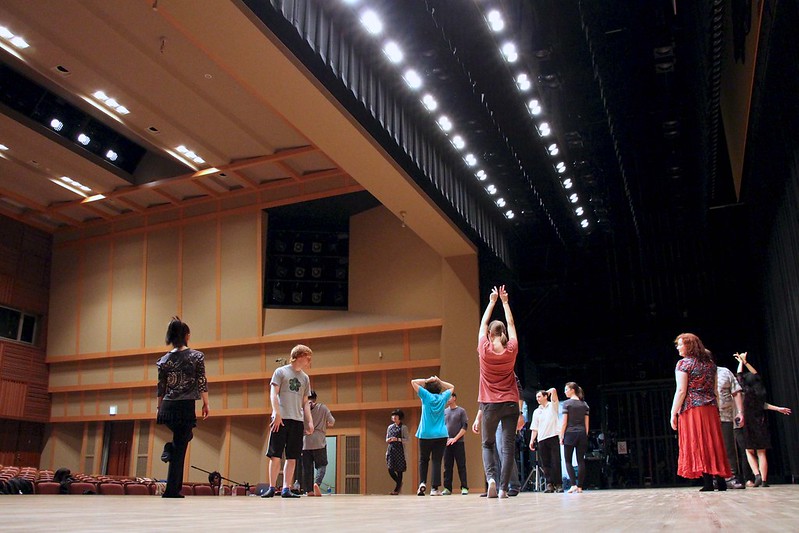“Those men are 50. They have some problems, because they are used in their tasks to work only with men. And when you’re a woman, and you direct, it can be very difficult to do it”. A female director shares her experience in the context of the Gender Equality Study, of the European Theatre Convention. An artistic director from the LGBTQIA+ community from Southern Europe argues that “we don’t have visibility in the arts with LGBTQIA+ community... Here’s open an audition, it will be either male or female, in a binary way, for example, there is no sensitivity yet” while a young female director from an Eastern European country confides that “I’m very aware of the fact that I’m a young female director. I’m very organized, I’m very structured, and I prep a lot and I work really hard. (...) I do this for people to immediately feel like, okay, she knows what she’s talking about.”
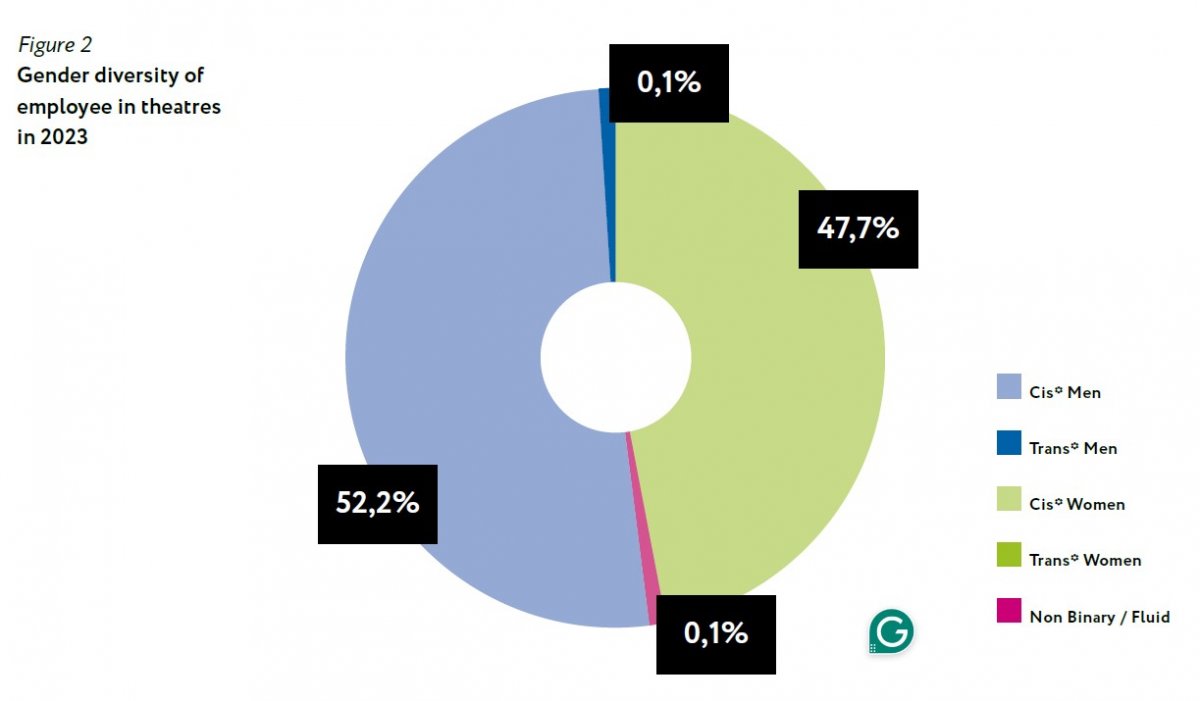
Conducted for ETC by Sarah Sepulchre, Jacinthe Mazzocchetti and Justine Vanhaelen of the Université catholique de Louvain, 'Gender Equality in European Theatres and Artistic Programmes' is an in-depth study of diversity on stage and in theatre staff teams across the continent. Using both quantitative and qualitative data, it takes a comprehensive approach to this important issue and seeks to provide tools for theatres across Europe to develop appropriate diversity strategies. "The findings of this study are critical to shaping the future of European theatre," says Heidi Wiley, ETC's Executive Director, in her release. "As we strive for a more equitable and inclusive sector, this research serves as both a call to action and a roadmap for meaningful change," she adds.
Diversity among theatre stuff

One of the very interesting conclusions to emerge from the quantitative data is that in terms of the total number of employees in European theatres, there is not a large gap between cis men (52.2%) and cis women (47.7%), but there is a very low representation of trans men (0.1%) and non-binary people (0.1%), and no representation of trans women. Looking at gender representation on the boards of organisations, the gap widens between cis men (56%) and cis women (44%) on the boards, with no other representation at this level. At the level of artistic directors of the organisations surveyed, 69% were cis men, 23% cis women and 8% self-identified as other.
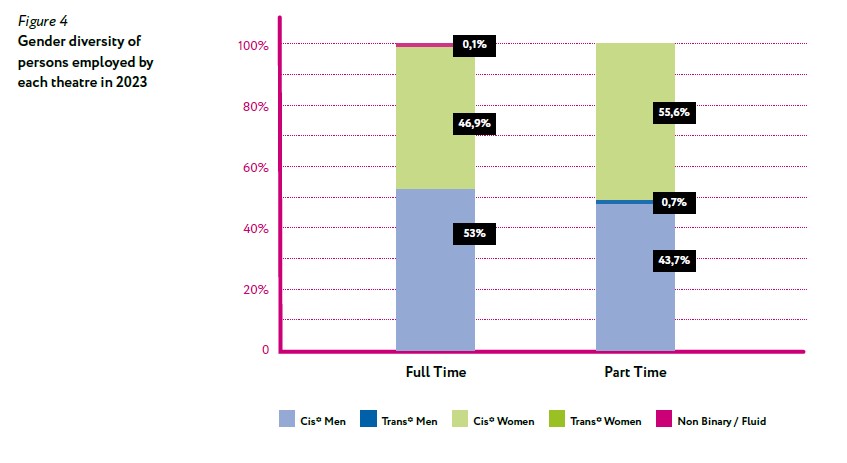
As the authors of the study point out, the small size of the corpus makes it impossible to make a statistically reliable comparison between these gender diversity figures, but it is interesting to note that the national institutions employ more men. On the other hand, the more independent organisations employ more women. Municipal institutions seem to employ more men and regional theatres seem to employ more women.
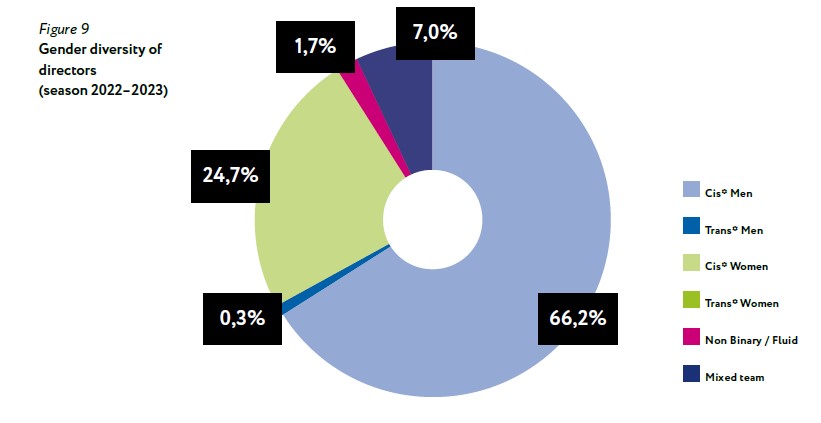
A woman director in a public theatre referred to a similar experience of her own. "I have also worked a lot in the independent sector," she said, "and of course there are a lot of women directors there because we have been pushed out by the money. The places that actually have money, like the big national institutions, you can't find women there".
Among full-time staff, the majority (53%) are cis men, while among part-time staff, the majority are cis women (55.6%).
Diversity in programming
The study's findings on gender representation in arts programming are also very interesting. In the cases studied, the vast majority of directors were cis men (66.2%), 24.7% cis women, 7% mixed team, only 1.7% non-binary and only 0.3% trans men. No trans women. The picture is similar for playwrights. 67% were cis men, 20% cis women, 11% mixed and only 1% non-binary.
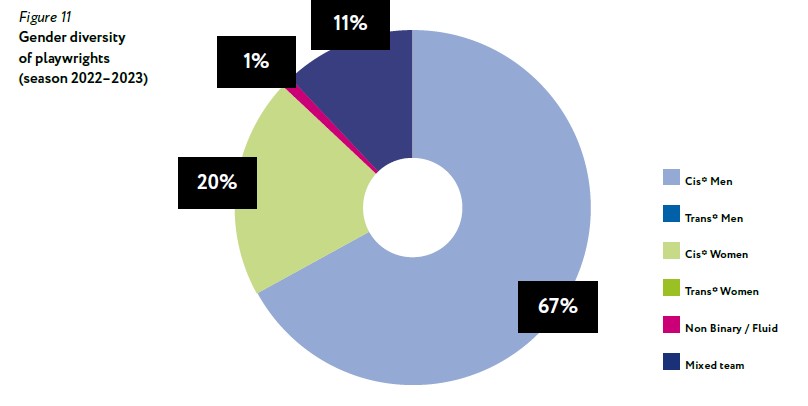
“If you are a woman, and you want to be a director, it’s not so easy, because the idea that directing is a men’s profession is very popular” said a female director of a public theatre in her interview as part of the survey, and her comment seems to fit with the findings above. While another interviewee from a Southern European organisation commented: “It’s not that we feel that we are on the margins. You can see that there is a patriarchy and there is always an extra effort that a woman has to do (…) there’s a long way to go to leave all this prejudice of the past behind, all these things that we were used to accepting because we were women”.
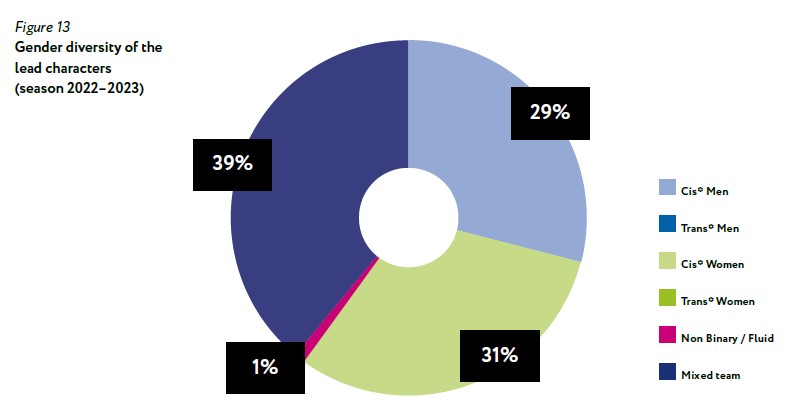
The picture is more divided when it comes to the representation of both genders among actors, but not among non-binary or trans people. According to the data, 31% of actors who had leading roles were cis women, 29% were cis men, 39% were a mixed group, while only 1% of leading roles were held by non-binary people. No trans people had a lead role.
Personal testimonies
This research is a continuation of α previous research carried out in 2021. In addition to the quantitative data, it also includes some very interesting qualitative data from interviews with women working in theatre management, who discuss their career paths, good practices for improving diversity, obstacles that may still exist, and share their experiences on the subject.
An interviewee from a theatre in Southern Europe commented to the researchers that “...gender problems are very deep because of our cultural roots. (...) In cultural work, for example, with men leading organisations, they choose women, like female directors or female actresses, or young as well, just to have a tick. Okay, I have a female on my list, because they must do it. It’s like purple washing sometimes.” Another one from Germany, referring to the me-too movement, said that “Of course, before Me-too, there had already been discussions why does this woman have to be naked on stage, what does it bring to the performance, and so on. But with the first Me Too, scandals suddenly start to be louder, and it was about misuse of power.”
The authors of the study hope that these personal testimonies, together with the reviews of relevant research recently published in Europe and included in the Gender Equality study, will be tools for theatres in Europe to develop appropriate diversity strategies. As an interviewee from Austria pointed out: “There’s awareness gained for the fact that it’s very white and male. I hope it’s structural. I’m not sure. Like, oh, we can’t show up with 10 male directors. That’s just not possible. I hope it’s a structural change, but at the moment, it sometimes feels a little bit, yeah, driven by fear.”
--
photo credit: namelesstheatrenagoya
photo source








